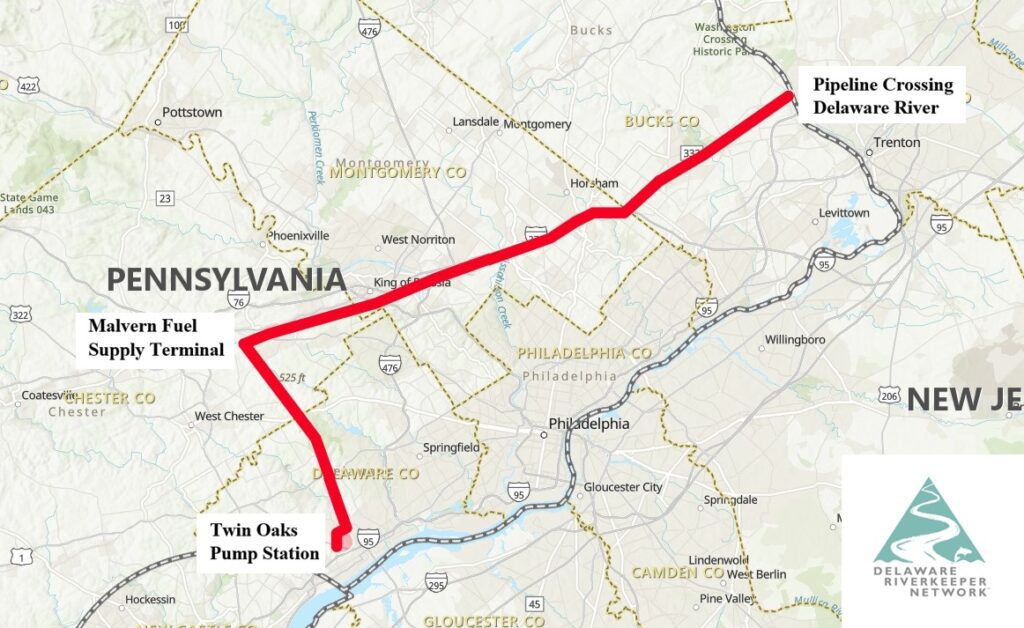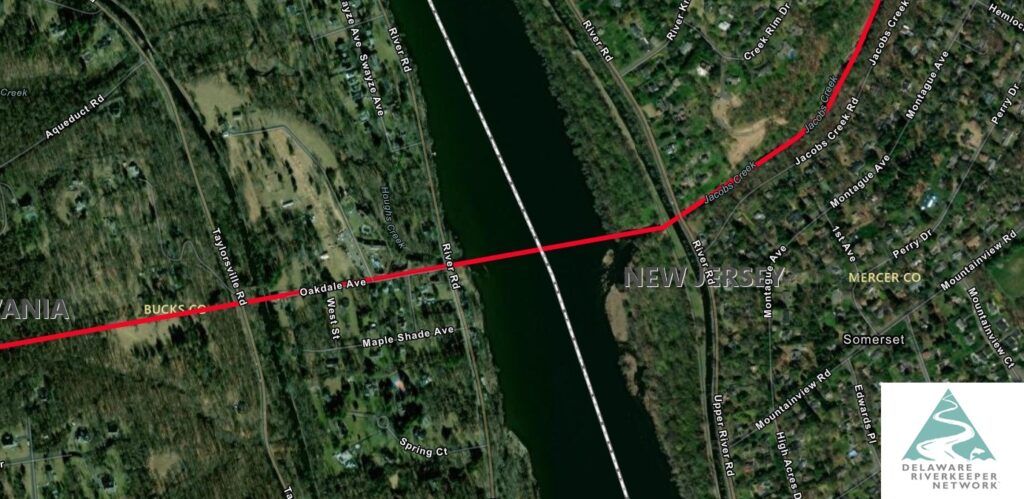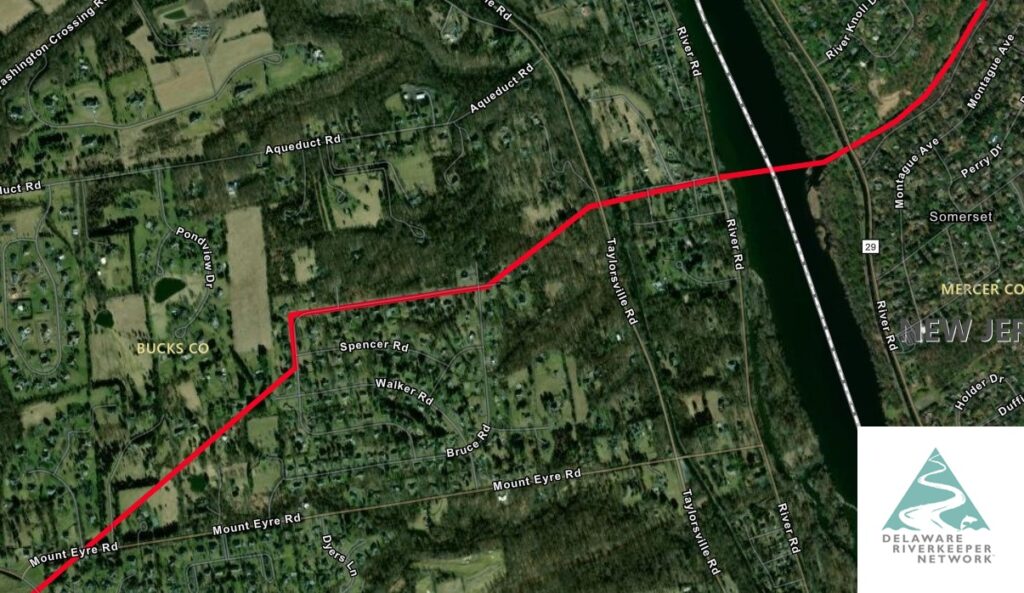The Salem Nuclear Generating Station is the largest predator in the Delaware Estuary.
The Salem nuclear generating station is owned and operated by the Public Service Electric and Gas Company (PSE&G) and is located on Artificial Island in Lower Alloways Creek Township in Salem County, NJ at the mouth of the Delaware River.
The Delaware Riverkeeper Network has been fighting for over 30 years to stop the unnecessary death toll that is having such serious impacts on the aquatic life of our River.
Once-Through Cooling (OTC) vs Closed-Cycle Cooling
More than five hundred of America’s oldest and dirtiest power plants still use “once-through cooling” (OTC) systems — the Salem Nuclear Generation Station, Delaware City Refinery, and Mercer Power Plant on the Delaware River are among them.
In once-through cooling, a power plant would draw large volumes of water from nearby lake or river to cool down heat produced from their operations. After being used, the power plant discharges this super-heated water back into the source along with other pollutants. The entire process, from intake to discharge, is responsible for destroying billions of fish, shellfish and other marine life. The death toll includes hundreds of endangered species of fish, mammals, and sea turtles. Some of these species like the Atlantic Sturgeon in the Delaware River, are being pushed to the very brink of extinction.
“Closed-cycle” cooling, is as it is described—essentially a closed loop that moves heated water to a cooling tower or pond where it can cool off through the surrounding environment, condense and be recirculated back into operation, instead of being discharged directly back into the source. Closed cycle cooling is a widely used and proven technology that has been available for decades and can reduce fish kills, habitat disruption, by drawing less water and putting out less thermal pollution into the environment.
By retrofitting the Salem plant with a closed cycle cooling system those fish kills could be reduced by over 95%.
Environmental Impact
The Salem Nuclear Power plant itself draws in over 3 billion gallons of water a day from the Delaware River to use in their cooling operations, killing over 3 billion fish a year (according correspondence from US Fish & Wildlife Service to NJDEP, June 30, 2000 relying on PSE&G’s own permit application data that is limited to 10 Representative Important Species (RIS)), which includes:
- Over 59 million Blueback Herring
- Over 77 million Weakfish
- Over 134 million Atlantic Croaker
- Over 412 million White Perch
- Over 448 million Striped Bass
- Over 2 billion Bay Anchovy
However, the US Environmental Protection Agency determined that Salem entrains 14.7 billion fish, eggs and larvae every year and impinges an additional 6.6 billion a year. (Case Study Analysis for the Proposed Section 316(b) Phase II Existing Facilities Rule Part A -B, figure B6-1, EPA, May 2002) Entrainment occurs when organisms are drawn through a cooling water intake structure into the facility’s cooling system and thereby become subjected to mechanical, thermal, and toxic stress. Organisms that become entrained are generally relatively small forms of fish and shellfish species. The mortality rate of entrained organisms is high. Impingement occurs when organisms are trapped against screening devices by the force of the water passing through the cooling water intake structure. Impingement can result in starvation and exhaustion, asphyxiation and descaling. While this is a direct loss of fish, it also creates a ripple effect on abundance of aquatic life from the food chain and all of the cascading benefits they provide to a host of other species.
Many of the species PSEG impacts are either endangered (such as Shortnose and Atlantic Sturgeon as well as Kemps Ridley and Green Sea Turtles) or have already experienced population declines in the present or recent past, thus magnifying the adverse impact of the Salem impingement and entrainment takes they suffer. For example:
- “The bay anchovy is a species whose numbers have been decreasing at an alarming rate.”[1]
- Blueback herring and Alewife have been identified by NOAA as a species of concern and one that has been experiencing declines throughout their range, including in the Delaware River.[2]
- The ASMFC has determined: “ The American shad stock in the Delaware River is considered stable but at low levels compared to the historic population.” (emphasis added) [3]
- Weakfish populations in our region are in a “depleted state.”[4]
- The Atlantic Sturgeon of the Delaware River are listed as endangered as part of the NY Bight DPS: “In the NYB DPS, there are two known spawning populations – the Hudson and Delaware Rivers. While the Hudson is presumably the largest extant reproducing Atlantic sturgeon population, the Delaware is presumably very small and extremely vulnerable to any sources of anthropogenic mortality.”[5]
[1] Bay Anchovy Fact Sheet, NJDEP, http://www.state.nj.us/dep/fgw/pdf/delriver/artdel_sp_bayanchovy.pdf
[2] River Herring (Alewife & Blueback Herring), Species of Concern, NOAA National Marine Fisheries Service, 5/19/2009.
[3] Delaware River Sustainable Fishing Plan for American Shad, Prepared by the Delaware River Basin Fish & Wildlife Management Cooperative for The Atlantic States Marine Fisheries Commission Shad and River Herring Management Board, December 2011.
[4] Atlantic States Marine Fisheries Commission, ADDENDUM IV TO AMENDMENT 4 TO THE WEAKFISH FISHERY MANAGEMENT PLAN, Nov 2009.
[5] Final Rule, Threatened and Endangered Status for Distinct Population Segments of Atlantic, Sturgeon in the Northeast Region, Fed Reg Vol 77 No. 24, Feb. 6, 2012.
The Federal Clean Water Act
Section 316(b) Regulations for Cooling Water Intake
Section 316(b) of the federal Clean Water Act sets requirements for cooling water intakes at certain facilities like the Salem Nuclear Generating Station that withdraw large volumes of water use the “best technology available” (BTA) on the design, construction and capacity of their cooling water intake structures to minimize any adverse environmental impact. (i.e. their kills of fish and aquatic life. Under these regulations,
In 1993 and 2006, The Delaware Riverkeeper Network along with a coalition of environmental groups filed suit against the EPA for failure to implement Section 316(b) of the Clean Water Act for existing power plants and other industrial facilities. After much decades of legal battles, on November 22, 2010 Delaware Riverkeeper Network and other groups entered into a settlement agreement in which the EPA would draft new regulations for existing facilities by March 14, 2011, and to take final action regarding the new regulations by July 27, 2012 along with other key provisions. The EPA published its new rules on August 15, 2014 which failed to set a clear standard, leaving it completely to the discretion of state regulators to determine what cooling water intake technology is best on a case by case basis. This failure subverts the entire purpose of the 316(b) regulation, to have a national baseline standard that provides all waterways the highest level of protection. Federal agencies responsible for protecting endangered species found that 266 threatened and endangered species are affected by power plants with once-through cooling, with the effects ranging from direct injury to habitat degradation and destruction of other aquatic species relied on as part of the aquatic food chain.
In September 2014, a coalition of environmental groups including the Delaware Riverkeeper Network, filed three lawsuits in federal courts around the country (New York, San Francisco and Boston) seeking to force the U.S. Environmental Protection Agency to establish a clear standard that better protects the hundreds of aquatic species near the nation’s 1,065 power plants and other facilities.
For decades, the power industry has campaigned against updating regulations to protect biologically and economically important aquatic ecosystems from further damage from industrial cooling water intakes. Industry argues that more environmentally protective regulations will force plants across the country to shut down and threaten the reliability of the nation’s electricity supply. But studies by EPA and by outside groups showed that the gradual move to closed-cycle cooling under this rule would have little or no impact on the power grid. In fact, EPA concluded that moving to closed-cycle cooling will actually reduce the vulnerability of the American power sector to droughts and climate change.
More information about this can be found here.
New Jersey Permit Renewal
In the past, rather than require this existing, used and proven technology, the state of NJ has primarily allowed PSE&G, the owner and operator of Salem, to “mitigate” its fish kills by changing the ratios of vegetation in wetlands. The problem is, this program does nothing to reduce the fish kills and according to PSE&G’s own data is not improving fish habitat or fish abundance in the Delaware River. Court rulings have made clear that mitigation is not an appropriate path for fulfilling the requirements of the Clean Water Act to minimize these fish kills.
In October 2013, the Delaware Riverkeeper Network filed on behalf of the Delaware Riverkeeper Network, New Jersey Sierra Club and the New Jersey Environmental Federation initiating a legal action requesting an order demanding that the New Jersey Department of Environmental Protection (NJDEP) take action on PSE&G’s permit renewal application for the Salem Nuclear Generating Station.
On November 13, 2014, the Delaware Riverkeeper Network, New Jersey Sierra Club and Clean Water Action settled their legal action against the New Jersey Department of Environmental Protection (NJDEP) and in-so-doing have secured a commitment from NJDEP to issue a draft discharge permit to PSE&G’s Salem Nuclear Generating Station by June 30, 2015. Issuance of the draft permit will cause NJDEP to take a position on whether the facility’s cooling water intake structures, must be updated to significantly reduce these fish kills and the facility’s water usage. Once the draft permit is issued the public will have a chance to submit comments and thereafter challenge any final NJDEP decision if it believes NJDEP has not required the proper level of environmental protection at the facility.
On, June 30, 2015, complying with the settlement agreement, the New Jersey Department of Environmental Protection (NJDEP) issued a draft permit which largely allows PSE&G to operate Salem business as usual.
While the State took 9 years to craft and issue this draft, they only gave the public 60 days and 1 hearing in which to review and comment. And both the comment period and the hearing occurred during the height of vacation season (July and August with the hearing on August 5). Nonetheless, the Delaware Riverkeeper Network submitted significant comments and expert reports on the draft permit issued by NJDEP for public comment. Amongst the findings of our experts:
- Two major analyses show that stopping the killing of fish with closed cycle cooling could provide economic benefits worth up to $577 million….. ECONorthwest, p. vii
- 14.7 billion fish a year are impinged and/or entrained at Salem. Closed cycle cooling at Salem would reduce this mortality by over 12.8 billion. ECONorthwest, p. 4
- 14.7 billion fish impinged & entrained at Salem a year translates into 360 million fish killed in an average year that, but for Salem, would have survived to age one. ECONorthwest, p. 4
- “The total installed cost of [closed cycle cooling at Salem] ($852 million) represents about 31 percent of the companies [PSEG & Exelon, Salem’s owners] combined annual capital expenditure, and the annual loan payment pf just two percent.” ECONorthwest, p. 24
- Installing closed cycle cooling at Salem “would increase electricity rates by $0.0036 per kWh.” ECONorthwest, p. 25
Copies of the Delaware Riverkeeper Network comment and expert reports can be found at:
Despite the significant expert, legal and factual challenges contained in our comment, on June 10, 2016, NJDEP issued a final permit that allowed PSE&G to essentially continue operations that result in the killing of over 14 Billion fish, eggs and larvae every year from our Delaware River. In response, on July 8, 2016 the Delaware Riverkeeper Network filed a legal challenge with the Office of Legal Affairs in New Jersey’s Department of Environmental Protection seeking a new hearing to review the renewed permit issued by NJDEP to PSE&G’s Salem Nuclear Generating Station located on Artificial Island in Salem County, NJ. The permit, as issued, would extend the Salem facility’s use of once through cooling. Throughout the legal battle NJDEP has sought to hide information from the public, forcing the Delaware Riverkeeper Network to have to engage in lengthy battles to gain access to text messages and emails sent by NJDEP staff regarding the issue and to secure the right to depose key NJDEP staffers who worked on the permit. Finally, on October 28, 2019, the New Jersey Office of Administrative Law granted the Delaware Riverkeeper Network’s motion to compel the deposition of three New Jersey Department of Environmental Protection (NJDEP) employees regarding the Salem Nuclear Generating Station’s New Jersey Pollution Discharge Elimination System (NJPDES) permit and to secure access to emails that had so far been denied the organization. While the Judge did not require NJDEP to produce unredacted pre-decisional drafts of the 2015 draft permit and the 2016 final permit, he overwhelmingly found in DRN’s favor on other requests. In a decision issued October 28, the judge granted DRN’s motion to compel the production of relevant emails. In addition, finding DRN demonstrated good cause, the judge granted the Delaware Riverkeeper Network’s request to take the depositions of key NJDEP employees. The judge’s determination in part states, “I CONCLUDE that petitioner has demonstrated “good cause” – specifically there has been a showing that information requested is highly technical in nature and cannot be obtained in other ways.”
To read the judge’s letter order, click here.
NJDEP appealed the October ruling. In a remarkable twist, in this administrative proceeding, the arbiter to whom the NJDEP appealed was the head of the NJDEP, Commissioner Catherine McCabe. On December 16, 2019, Commissioner McCabe ruled against DRN’s right to take the depositions of three NJDEP employees. In her ruling, Commissioner McCabe suggested that allowing the depositions would “set a precedent that makes depositions routine in all permitting matters and will cause an undue burden on the Department.”
Despite this unsavory legal development, discovery in the case has continued to advance as has our legal challenge. It has been a slow slog but we continue to pursue this precedent setting legal challenge essential for protecting our Delaware Estuary and the fish and aquatic life essential ecologically, recreationally, and economically.
On a related note: on August 13, 2019, once again, the Delaware Riverkeeper Network has reached out to the National Marine Fisheries Service (NMFS) to urge them to take action protect the endangered Atlantic Sturgeon of the Delaware River. Time and again we have reached out about the excessive takes of sturgeon by both the Army Corps of Engineers and by PSEG’s Salem Nuclear Generating Station. Every time they turn a blind eye. When will it stop? See the letter and horrific photos here.
Related Issues







